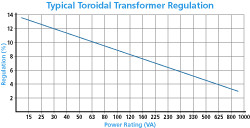Transformer regulation is a measure of the voltage rise on the secondary due to off-load or light-load conditions with the primary input voltage remaining constant. This measure is expressed as a percentage of the secondary voltage; for example, a transformer with 10% regulation and rated at 12v at full load will have an off-load voltage of 13.2v.
Regulation is calculated as:

Due to the design characteristics of transformers, regulation varies inversely with power rating (VA) and is approximately linear for any given loading on the secondary. In the above example, if the load was 50% of full load, the voltage would be 5% higher, or 12.6v. This regulation figure must be borne in mind when designing rectifier power supplies, etc. as it will affect the voltage rating of reservoir capacitors, voltage regulators, etc.
Custom transformers can be designed with very low regulation figures but only at the expense of size and weight, as larger cores and wire gauges must be used. Following are some typical regulation figures for standard transformer VA ratings.

|